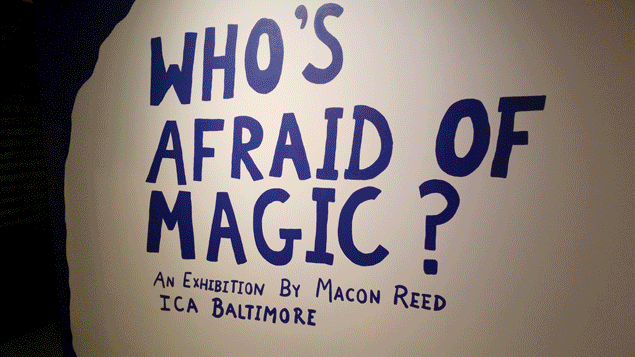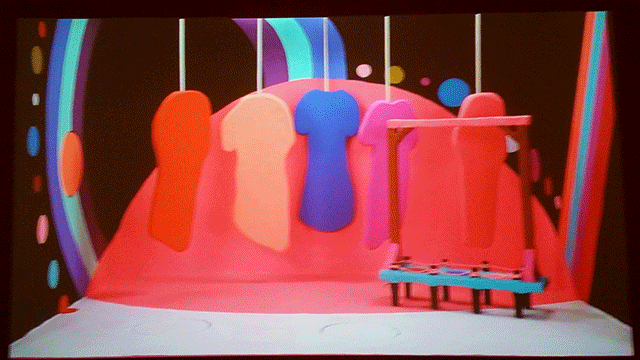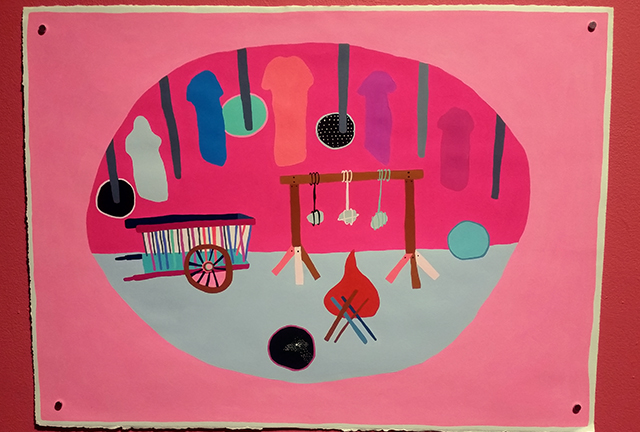Macon Reed: Who’s Afraid of Magic?
Institute of Contemporary Art Baltimore at SpaceCamp
16 West North Ave, Baltimore, MD 21202
On view until December 18th

Macon Reed doesn’t do anything half-assed. We know this personally, because she offered to fly to Miami last year for 24 hours to help faux-finish the walls of our pop-up F.A.G. Bar, where AFC was exhibiting excerpts from her epic installation Eulogy For the Dyke Bar.
Still, I was caught off-guard by the ambition and execution of her current solo show with the ICA Baltimore, Who’s Afraid of Magic? The cavernous SpaceCamp gallery is a challenging space for artists to fill, but here the artist has transformed it with pieces that operate at different sizes, from the theatrical to intimate. On one wall, a larger-than-life pastel mural sets a deceptively cheery backdrop for the exhibition. Abstracted forms that reference the body burn in a tableau of cutesy-looking medieval torture implements—gore-free, it’s an unnervingly sanitized illustration of violence. That’s not what one would expect from an exhibition inspired by Silvia Federici’s Caliban and the Witch, a text about witch hunts and cruelty in the not-so-distant centuries when superstition began to share the European consciousness with nascent capitalism.

“Hammer of Witches,” “Breast Ripper,” “Scold’s Bridle,””Witch Cart,” “Gallows,” “Birth Chart of The Plague,” “Fire,” all Acrylic gouache on watercolor paper, 2016.
Opposite the mural, a series of seven small framed paintings on paper scale Reed’s signature style down to focus on individual objects. Each depicts a horrific implement of torture such as the “Scold’s Bridle” or “Breast Ripper”. (The latter of which, perhaps deliberately, takes on a vaguely phallic shape when rendered in Reed’s DIY-patent-illustration style.) They’re disarmingly approachable, reminding me of the cheery Harry Potter Lego sets my nieces collected at the turn of the millennium. It’s not until reading the adjacent text that one realizes the harsh reality of the fantasy-looking illustrations.

GIF of excerpts from “The World Must Suffer A Big Jolt,” 2016.
That playful vibe carries through most of the work here, most notably in the video piece “All The World Must Suffer A Big Jolt,” wherein the artist’s hand appears in a diorama, rearranging an abstracted lynching tableau as if it’s a doll house. The morbid nature of the subject is muted by the reduction of the human bodies to simple garment-like forms. These robe/blobs too seem to reference male castration as much as violence against female bodies—it’s hard to not see the gallows humor of disembodied dicks strung up in a row—perhaps a long overdue revenge against the femicidal patriarchy? In another video, “Witchual”, a coven of queer performers enact an esoteric ritual in the woods. In these video works, the question Who’s Afraid of Magic? seems less pointed and more absurd—whatever inscrutable actions are being performed here seem beguilingly harmless.
I’m tempted to say the show feels timely, what with the Right-Wing’s paranoia over Marina Abramović’s “Spirit Cooking” party with the Podestas, the even more bizarre #pizzagate occult conspiracy theory, and the general air of misogyny that’s permeated the political discourse of 2016. But the sad reality seems to be that a certain segment of society will always be enraptured in a “Satanic Panic,” as the 80s tabloids called it. Remember when even comparably innocent Harry Potter elicited book burnings and bans from Christian parents? The “witch hunt” is an archetype of Western culture, standing in as a parable for McCarthyism in The Crucible and even drawing contemporary comparison to the Left’s divisive mob-mentality “call-out culture”. It’s less of a stretch to liken the witch hunt to Republicans’ scapegoating of trans*, immigrant, and Muslim demographics.

“Ancestral Witness,” Acrylic gouache on watercolor paper, 2016.
So maybe the biggest surprise here is how ambiguously Reed leaves the work’s connection to the omnipresent politics of 2016. The “witch hunt” is a useful figure of speech, to be sure, but it’s also one based on horrific historical fact. In Who’s Afraid of Magic?, that history is allowed to live as something independent and new—not quite didactic canon and, refreshingly, not quite mere metaphor to allude to something else. Dark reality is tempered by a sense of whimsy that feels so much more twisted.
The morbid playfulness of this show might be its real strength—about halfway through the exhibition I was bothered by the lack of individual identities for the women whose suffering is referenced here, but in retrospect that anonymity maybe made this work less intimidating. In a strange way, it’s probably easier to empathize with the highly-redacted idea of persecution than an individual victim. Reed’s work effectively invites us in for some make believe, but hands us a dose of reality that’s even harder to swallow when sugar-coated.


Comments on this entry are closed.